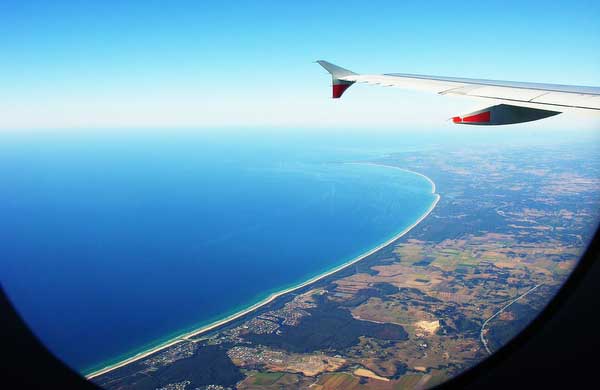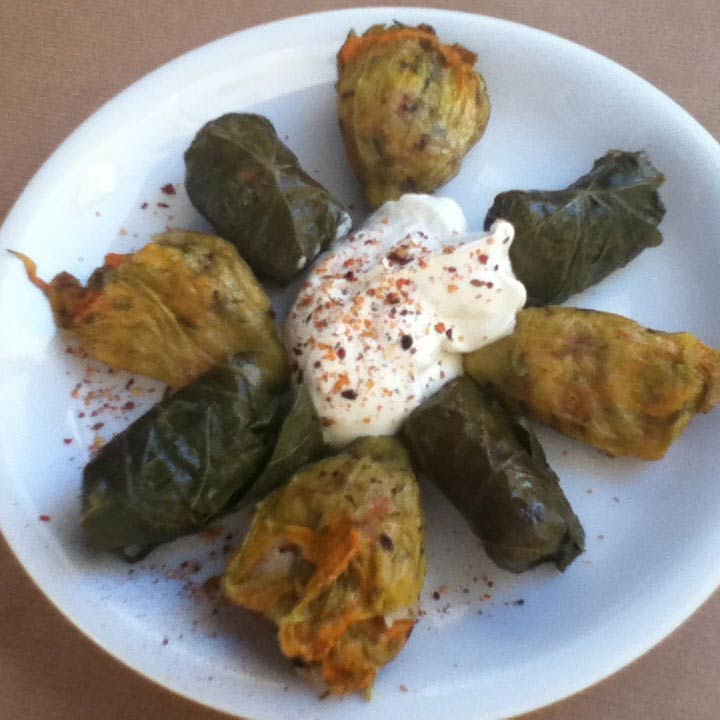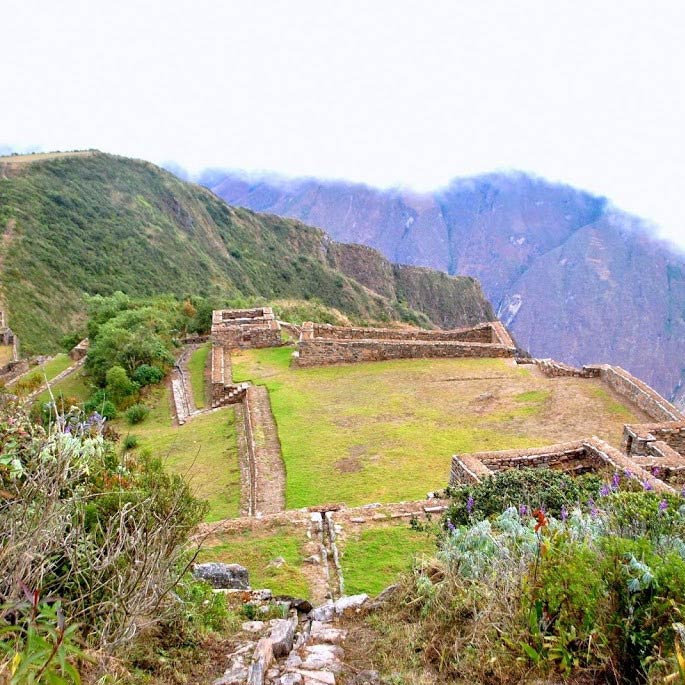7 Awesome Reasons why You Should Travel to Australia
By Marie Nieves
When visiting Australia, the worst thing you can do is staying at one place the entire time. Not because certain cities are uninteresting or not worth seeing, but because there is so much out there – literally out there! Here are seven reasons why you should come here.
1. Big Cities
2. Festivals
3. Food

4. Wellness and Spa
5. National Parks and Nature
6. Beaches
7. Islands
In Conclusion
Why Great Lent in Greece is Great for Vegan Travellers
By Wendy Werneth
The traditional Greek diet uses fresh fruits and vegetables and the Greek Orthodox religion has shaped the local cuisine. That's why Lent is full of vegan food and it's a good time for vegeterian or vegan travellers to visit Greece!
Find a Flight to Greece Sample Flight to Greece in April
If I asked you to describe Greek food, the phrase "vegan-friendly" would probably not be the first thing that popped into your head. For most people, Greek food means gyros (the meat you see roasting on a revolving spit in kebab joints the world over), souvlaki (barbecued pieces of meat on a skewer), and plenty of dairy products such as feta cheese, Greek yoghurt or tzatziki. Doesn't exactly sound like a veggie paradise, does it? Well, the good news for vegan travellers is that this couldn't be further from the truth! The traditional Greek diet actually uses meat very sparingly, while fresh fruits and vegetables are found in abundance. While this is true of a number of Mediterranean countries, in Greece it is even more the case, due to the role that the Greek Orthodox religion has played in shaping the way Greeks eat.
The Orthodox calendar includes more than 180 "fasting" days, when the faithful follow a nearly vegan diet and abstain from eating any land animals, eggs, dairy products or fish (though they still eat honey and some aquatic animals such as shrimp or octopus). As you might imagine, this has had a huge influence on the development of Greek cuisine, which includes an incredible variety of naturally vegan dishes. And, while these dishes are widely available in restaurants year round, the best time to look for them is during the seven-week period leading up to Orthodox Easter, which is the most important fasting period and is known as the "Great 40 Days", the "Great Lent" or the "Great Fast". During this time, restaurants are likely to offer even more nistisimo ("fasting") foods than usual. Below is just a sampling of the dishes you can expect to find.
- Aginares a la Polita: a stew made with artichokes, carrots, and potatoes and flavoured with lemon and dill.

- Briám: an oven-baked dish similar to ratatouille in Southern France. The vegetables used can vary but always include potatoes and zucchini.

- Gemista: tomatoes or red bell peppers stuffed with a rice and herb mixture. Occasionally contains minced meat but is usually vegan.

- Imam Baildi: A whole braised eggplant stuffed with onion, garlic and tomatoes and simmered in olive oil until soft enough to melt in your mouth. Delicious!

And don't overlook the mezedhes (appetizers) at the front of the menu. It is quite common to make a meal out of a selection of these small dishes. Here are some to look out for:
- Tomatokeftedes: tomato fritters with mint, fried in olive oil.

- Gigantes: giant white beans cooked in tomato sauce and various herbs.

- Melitzanosalata – a cold eggplant dip similar to baba ghanoush.

- Dolmadhes – grapevine leaves stuffed with rice and herbs

- Skordalia – a dip made with mashed potatoes and lots of garlic

And that's just to name a few! While all these dishes are usually vegan, recipes can vary from one restaurant to another, so ask to be sure.
While the above dishes are commonly found throughout the country, there is also plenty of regional variety in Greek cuisine. The island of Crete, for example, is particularly famous for its local dishes and cooking style. If you're heading that way, be sure to look out for Kolokythoanthoi.These are similar to dolmadhes, except that the vine leaves are replaced with the more delicate zucchini flower, which is stuffed with rice and herbs. Just be sure to ask your server to hold the yoghurt, which is normally served on the side.
Another vegetarian Cretan dish that can easily be veganized is dakos (sometimes spelled ntakos). To make dakos, you begin with a couple of slices of paximadi – a rusk or hard, dried bread made from barley that is a local specialty in itself. These are moistened with a few tablespoons of water and then topped with chopped tomatoes, olive oil, olives and herbs. Feta or mizithra cheese is normally also part of the topping, but it's no problem to ask for dakos without it. .
.
Santorini – an island whose sunsets are wildly popular among travellers to Greece – is also known for the high quality of its local agricultural products, thanks to the fertile volcanic soil. Some of the more famous produce items include capers, cherry tomatoes, white eggplant and a legume with the scientific name of lathyrus clymenum that is not cultivated anywhere else in the world. The latter is the main ingredient in a popular meze dish called fava. This name can be misleading, because it actually bears no relation to fava beans (otherwise known as broad beans). Rather, the lathyrus clymenum is a type of pea that is similar to the yellow split peas used to make dhal in India. In Santorini then, fava is a dip made from puréed yellow split peas.
Now, with all these naturally vegan dishes found in traditional Greek cuisine, there's not much reason to seek out vegetarian restaurants in Greece. Which is just as well, because you won't find many. As vegan-friendly as Greece is, the concept of veganism (or even vegetarianism) is not that widely known, and if you say to someone that you are vegan they are unlikely to understand you. So vegans, remember the magic word – nistisimo! As long as you ask for nistisimo ("fasting") food and make it clear that you do not eat any seafood (or honey, if that's the case), then you should be good to go. And if you aren't vegan, don't let that stop you from trying some of these delicious Greek specialties! They have been pleasing the tastebuds of Greek meat-eaters and non-meat-eaters alike for generations.
This awesome text was brought to you by Wendy - author of The Nomadic Vegan Blog
Best Archeological Sites in Peru
By Ela Bader
The mysterious Peruvian land was once a home for many ancient civilizations which left traces in the form of cities, temples, labyrinths, bridges and perplexing statues. Nowadays, they are admired for the complex and magnificent architecture. Here is a list of the most interesting archaeological sites in Peru (from my experience of backpacking through a large part of this country).
Choquequirao
Situated at an elevation of 3000 meters in the Andean mountains and surrounded by mighty rivers, this ruin complex is comparable to Machu Picchu in terms of immense size and sophisticated architecture. Nonetheless, it is far less visited. An intense two day hike through steep mountains is the only way to get to this impressive site and only few people a day make it there. If you're lucky you may even have the site just for yourself (contrary to Machu Picchu where you have to share it with roughly 2000 other visitors). The hike there is a lifetime adventure but be prepared for difficulties. The trails are zigzagging sharply up and down and there is no flat surface. It was the most difficult hike I've done so far but how rewarding! The majestic Andes surround you at every step and the mighty river is flowing between the mountains providing epic views during the whole hike.
|
|
 |
Chavín de Huántar
This ruin complex was once a pilgrimage site for the individuals from Chavin civilization. Constructed between 1500 and 300 BC it consists of a massive temple, plaza and the labyrinth. It was a ceremonial center which offered a spiritual and psychedelic experience. Participants were given hallucinogenic San Pedro cactus, then entered the complicated underground labyrinth accompanied by sounds of trumpets and water running below their feet (the site hosted a complex canal system). All that to confuse a person walking in the labyrinth and enhance the spiritual experience. To get the atmosphere even more, try a two days hike in Cordilliera Blanca just as ancient Chavin pilgrims did some 3000 years ago. Locals selling souvenirs at the site sometimes offer tours of the site accompanied with San Pedro cactus consumption.
 |
 |
Nazca
Seen only from the plane or high hills, Nazca lines form various designs such as spider, birds, monkey, tree, possible astronaut. These lines were drawn by moving the black rocks and reveling the light color sand underneath. Due to the lack of rain the lines stayed intact for 2000 years. Multipule theories about why the lines came into existence range from contact with aliens to astronomical purpose, but the version I heard when visiting the site was that Nazca people created them for the gods, who could see them only from the sky. If you're in the area don't miss the Nazca cemetery with its creepy open graves... Many bones that lay aroung the graves were left behind by plundering thieves who robbed the bodies from gold and other valuables they were buried with.
 |
 |
Chan Chan
The largest Pre-Colombian city in South America, Chan Chan was created by Chimu civilization. The site contains various adobe constructions covered with intricate designs. The scale of the site is breathtaking, and the designs on the adobe walls are a reminiscence of a grand civilization that once inhabited those lands. Unlike other ruins in Peru, Chan Chan was constructed very close to the Pacific Ocean. The proximity of the water had influence on the daily activities of citizens of Chan Chan. Those are depicted in various carvings of fish, crabs, turtles, and fishing nets. Another characteristic that makes Chan Chan unique is that the site has many ramps and no stairs. To increase the farming Chimu civilization created the canal system. It improved the farming for some time but was later destroyed by flood. A small lake is remaining from those ancient times and it looks like an oasis surrounded by yellow sand of this desert. Unfortunately, a vast part of Cha Chan was destroyed by the centuries of rain and only small part of this once monumental city remains.
 |
 |
Moray
The alien looking Moray can be easily visited thanks to it's proximity to Cuzco. Numerous levels of terraces are aligned in the valley creating a temperature difference of as much as 15 °C (27 °F) between the top and the bottom. Archaeologists suggest that Moray was an Inca agricultural experiment station. Each level has a different micro-climate, making it ideal for crop testing. According to our guide, Incas planted different species of potatoes, plantains and other vegetables on different levels. This was done to distinguish which species will do better in cold and hot temperatures. The ones that adopted the best were distributed to different parts of Inca empire to make the most out of their sophisticated agriculture.
Machu Picchu
This very popular tourist attraction was left to the end of the list on purpose. Amazing as it is, it attracts a big number of tourists, therefore it offers a completely different experience then the previously mentioned sites. Regardless of the crowds, it remains a marvelous monument of Inca's architecture and their love for the highlands. It is situated on a mountain ridge which offers magnificent views as well as mystic fog invading the site at different times of the day. If you travel on a budget it's worth to consider walking to Aguas Calientes (the closest town to Machu Picchu) instead of taking an expensive train. It's a good idea to arrange the tickets a day in advance as the entrance to viewpoints Huayna Picchu and Montana Machu Picchu are limited.
The story of Machu Picchu is intriguing and is it's purpose is still unknown. The popular version is that Machu Picchu was a holiday resort for elite Incas. The Incas started building it around 1430AD in this hidden location which prevented it from being destroyed by Spanish conquistadors during their invasion on the Inca Empire.
|
|
|
Visit Chile home to volcanos, deserts, sea lions... and a hitchhikers paradise!
By Ela Bader
Our adventure in this country started when we crossed the border from Argentina and the city of Valdivia was our first destination. There, we've seen the sea lions which come near the fish market where people feed them. Later we went to Pucon for the pools with natural hot water coming from the geysers. The pools were beautifully situated in
the mountains. Our next destination was Santiago, the capital of Chile. We were hosted by a friendly couple who made a crevice party the day we arrived. In Santiago we went to the local market and couple of museums. The most impressive was 'Museo de la memoria' - the museum about the Pinochet dictatorship, probably the most difficult period in Chile's history during which millions of people died, disappeared or was tortured because they were considered political enemies.
After Sanitago we went to La Serena, the beach town where we were hosted by the British guy who was a chef of Scotland Yard and now he moved to Chile as he married here. The city was close to Valley Elqui - amazing desert valley, with many sky observatories and pisco factories (pisco- grape brandy produced in Chile). From La Serena we went far north, to San Pedro de Atacama. We were very lucky with hitchhiking as we met Ronny- a friendly guy who gave us a ride and also spend a day showing us amazing places around the area. We went to Valle de la Luna, the valley which resembles moon surface and Valle de la Muerte- death valley- so dry that nothing lives there. We also tried the dust boarding on the sand dunes, which was a lot of fun. In San Pedro we were hosted by a young couple from Chile and England. With them we went to other hot pools (as there are a lot of volcanoes and geysers in Chile, there are also a lot of hot streams and pools with natural hot water).
From San Pedro we crossed the border to Bolivia. Chile was a fascinating place for us. The country is very diverse geographically, ranging from glaciers and snow-covered volcano peaks in the south to dry and hot desert in the north. The desert part is especially interesting as it seems like another planet. We met a lot of friendly and helpful people, and we managed to visit all the places we wanted by hitchhiking, which in Chile works very well. We've never waited for a ride more then 15 min. We've learned from the drivers that hitchhiking is very popular in Chile as all the university students travel with their backpacks to explore their country and often hitch a ride. Chile is also very similar to Europe in terms of culture and lifestyle so we felt like home. We could easily mix in the crowd and feel like locals. When we crossed the border and arrived in Bolivia we encountered a completely different reality, but this will be a subject of another post:






















